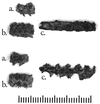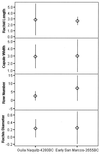Archaeological evidence of teosinte domestication from Guilá Naquitz, Oaxaca - PubMed (original) (raw)
Archaeological evidence of teosinte domestication from Guilá Naquitz, Oaxaca
B F Benz. Proc Natl Acad Sci U S A. 2001.
Abstract
Analysis of the three most ancient Zea mays inflorescence fragments from Guilá Naquitz, Oaxaca, Mexico shows they did not disarticulate naturally, indicating that agricultural selection of domesticated teosinte was underway by 5,400 (14)C years before the present (about 4,200 dendrocalibrated years B.C.). The cooccurrence of two-ranked specimens with two rows and four rows of grain and numerous additional morphological characteristics of these specimens support hypotheses based on molecular and quantitative genetic analyses that maize evolved from teosinte. Domestication of the wild ancestor of maize occurred before the end of the 5th millennium B.C.
Figures
Figure 1
Photograph of three Guilá Naquitz archaeological cobs. Specimens a and b from C9. Cob apex is at left (Upper) or at right (Lower). All three specimens have two ranks of cupules. Specimens a and b have a single spikelet per node, i.e., a single grain per cupule. Specimen a (Upper) shows abaxial side (away from axis), whereas specimen b (Upper) shows adaxial (toward axis) side of bilaterally symmetrical distichous inflorescence. Specimen a (Lower) shows one rank of spikelets on abaxial side, whereas specimen b (Lower) shows abaxial side. Perpendicular orientation of lower glumes of two-rowed specimens is visible in specimens a and b (Lower). Specimen c is the distichous four-rowed specimen from D10. The alternate arrangement of opposing rachids, shallow cupules, and the perpendicular to reflexed lower glumes are visible in Lower, whereas paired spikelets and open cupules are visible in U_pper_. Specimens are actual size. (Scale = 6 cm.)
Figure 2
Morphometric comparison of the three archaeological specimens from Guilá Naquitz on left with the three earliest archaeological specimens from San Marcos cave, Tehuacán Valley, Puebla, Mexico on right. Rachid length and cupule width are in millimeters; rachis diameter is in centimeters; diamonds indicate mean; error bars represent the 95% confidence interval.
Comment in
- Documenting plant domestication: the consilience of biological and archaeological approaches.
Smith BD. Smith BD. Proc Natl Acad Sci U S A. 2001 Feb 13;98(4):1324-6. doi: 10.1073/pnas.98.4.1324. Proc Natl Acad Sci U S A. 2001. PMID: 11171946 Free PMC article. No abstract available.
Similar articles
- The earliest archaeological maize (Zea mays L.) from highland Mexico: new accelerator mass spectrometry dates and their implications.
Piperno DR, Flannery KV. Piperno DR, et al. Proc Natl Acad Sci U S A. 2001 Feb 13;98(4):2101-3. doi: 10.1073/pnas.98.4.2101. Proc Natl Acad Sci U S A. 2001. PMID: 11172082 Free PMC article. - Domestication and lowland adaptation of coastal preceramic maize from Paredones, Peru.
Vallebueno-Estrada M, Hernández-Robles GG, González-Orozco E, Lopez-Valdivia I, Rosales Tham T, Vásquez Sánchez V, Swarts K, Dillehay TD, Vielle-Calzada JP, Montiel R. Vallebueno-Estrada M, et al. Elife. 2023 Apr 18;12:e83149. doi: 10.7554/eLife.83149. Elife. 2023. PMID: 37070964 Free PMC article. - Microfossil evidence for pre-Columbian maize dispersals in the neotropics from San Andres, Tabasco, Mexico.
Pohl ME, Piperno DR, Pope KO, Jones JG. Pohl ME, et al. Proc Natl Acad Sci U S A. 2007 Apr 17;104(16):6870-5. doi: 10.1073/pnas.0701425104. Epub 2007 Apr 10. Proc Natl Acad Sci U S A. 2007. PMID: 17426147 Free PMC article. - The genetics of maize evolution.
Doebley J. Doebley J. Annu Rev Genet. 2004;38:37-59. doi: 10.1146/annurev.genet.38.072902.092425. Annu Rev Genet. 2004. PMID: 15568971 Review. - The arches and spandrels of maize domestication, adaptation, and improvement.
Abraham-Juárez MJ, Barnes AC, Aragón-Raygoza A, Tyson D, Kur A, Strable J, Rellán-Álvarez R. Abraham-Juárez MJ, et al. Curr Opin Plant Biol. 2021 Dec;64:102124. doi: 10.1016/j.pbi.2021.102124. Epub 2021 Oct 26. Curr Opin Plant Biol. 2021. PMID: 34715472 Review.
Cited by
- The Analysis, Description, and Examination of the Maize LAC Gene Family's Reaction to Abiotic and Biotic Stress.
Wang T, Liu Y, Zou K, Guan M, Wu Y, Hu Y, Yu H, Du J, Wu D. Wang T, et al. Genes (Basel). 2024 Jun 6;15(6):749. doi: 10.3390/genes15060749. Genes (Basel). 2024. PMID: 38927685 Free PMC article. - Combining QTL-seq and linkage mapping to uncover the genetic basis of single vs. paired spikelets in the advanced populations of two-ranked maize×teosinte.
Chen Z, Tang D, Hu K, Zhang L, Yin Y, Ni J, Li P, Wang L, Rong T, Liu J. Chen Z, et al. BMC Plant Biol. 2021 Dec 4;21(1):572. doi: 10.1186/s12870-021-03353-3. BMC Plant Biol. 2021. PMID: 34863103 Free PMC article. - Starch grain and phytolith evidence for early ninth millennium B.P. maize from the Central Balsas River Valley, Mexico.
Piperno DR, Ranere AJ, Holst I, Iriarte J, Dickau R. Piperno DR, et al. Proc Natl Acad Sci U S A. 2009 Mar 31;106(13):5019-24. doi: 10.1073/pnas.0812525106. Epub 2009 Mar 23. Proc Natl Acad Sci U S A. 2009. PMID: 19307570 Free PMC article. - Epistatic interactions between Opaque2 transcriptional activator and its target gene CyPPDK1 control kernel trait variation in maize.
Manicacci D, Camus-Kulandaivelu L, Fourmann M, Arar C, Barrault S, Rousselet A, Feminias N, Consoli L, Francès L, Méchin V, Murigneux A, Prioul JL, Charcosset A, Damerval C. Manicacci D, et al. Plant Physiol. 2009 May;150(1):506-20. doi: 10.1104/pp.108.131888. Epub 2009 Mar 27. Plant Physiol. 2009. PMID: 19329568 Free PMC article. - Genome-wide association studies revealed complex genetic architecture and breeding perspective of maize ear traits.
Khatun M, Monir MM, Lou X, Zhu J, Xu H. Khatun M, et al. BMC Plant Biol. 2022 Nov 18;22(1):537. doi: 10.1186/s12870-022-03913-1. BMC Plant Biol. 2022. PMID: 36397013 Free PMC article.
References
- Long A, Benz B, Donahue D, Jull A, Toolin L. Radiocarbon. 1989;31:1035–1040.
- Flannery K V, editor. Guilá Naquitz. Orlando, FL: Academic; 1986. pp. 7–8.
- Benz B, Iltis H. Am Antiq. 1990;55:500–511.
- Doebley J. Econ Bot. 1990;44,Suppl.:6–27.
Publication types
MeSH terms
LinkOut - more resources
Full Text Sources
Other Literature Sources

